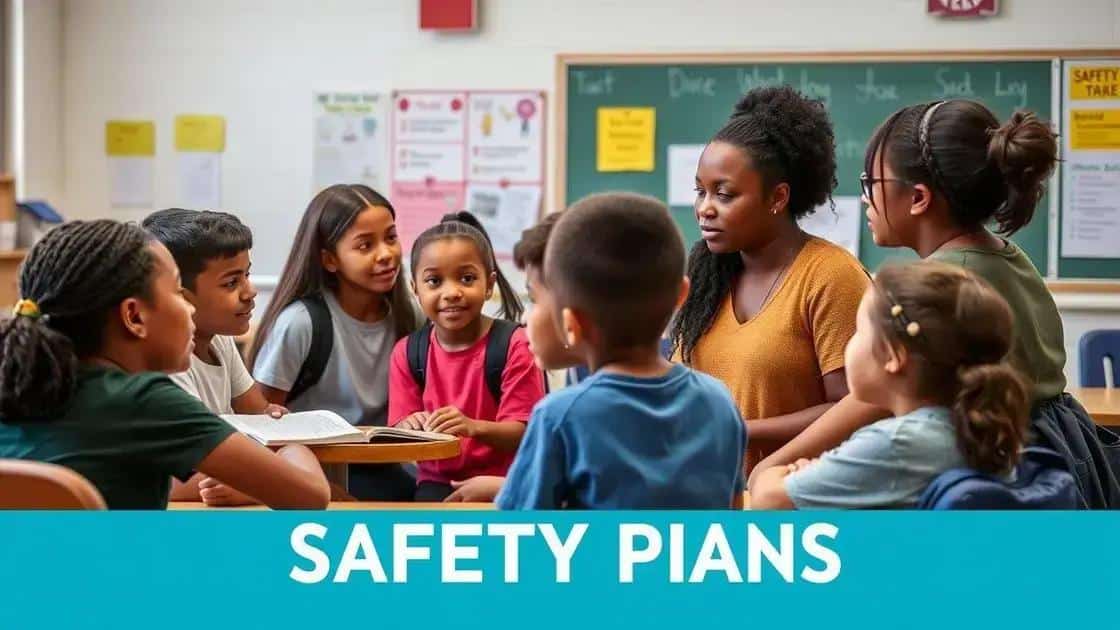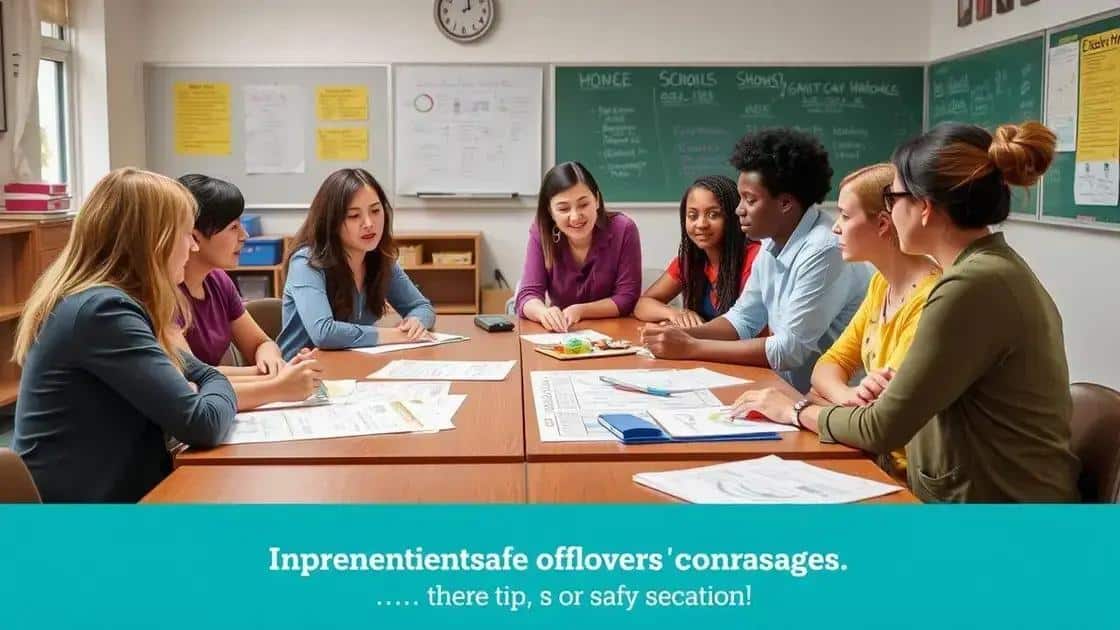Allow school safety initiative: how it transforms campuses

The allow school safety initiative focuses on enhancing student protection by fostering community engagement, implementing effective safety measures, and continuously evaluating their impact on student well-being.
The allow school safety initiative plays a crucial role in enhancing security for students and staff. Have you thought about how these programs can change your local school environment for the better? Let’s dive in.
Understanding the allow school safety initiative
Understanding the allow school safety initiative is crucial for enhancing security in educational environments. These initiatives focus on creating safer spaces for students and staff, ensuring a conducive learning atmosphere.
Core Objectives of the Initiative
The main goals of the allow school safety initiative include:
- Reducing incidents of violence in schools.
- Implementing effective emergency response plans.
- Educating students and staff about safety protocols.
- Encouraging collaboration with local authorities for comprehensive safety measures.
These objectives aim to address various aspects of safety within a school environment. Additionally, community involvement is important. Engaging parents and local organizations helps strengthen these safety efforts.
Key Components of the Initiative
The allow school safety initiative encompasses several essential components. These components work together to create a holistic approach to school safety. They include:
- Risk assessment: Identifying potential hazards and vulnerabilities within the school.
- Training programs: Providing staff and students with the necessary knowledge and skills for emergency situations.
- Physical security improvements: Enhancing building infrastructure with secure entrances and surveillance systems.
Implementing these components effectively is vital for sustaining a safe learning environment. As schools adapt to modern challenges, staying informed about emerging best practices is key.
In conclusion, the allow school safety initiative is not just about rules; it’s about fostering a community where safety is prioritized. By working together, schools can enhance their safety measures and create a positive environment conducive to learning.
Key components of effective safety programs
Key components of effective safety programs are essential to ensure a secure environment for students and staff. Understanding these components is vital for any school aiming to improve safety.
Essential Elements of Safety Programs
Firstly, every safety program should include a comprehensive risk assessment. This helps identify potential threats and unveil vulnerabilities within the school’s infrastructure. Following this, schools must establish clear policies that define roles during an emergency.
- Staff training: Regular training sessions ensure that everyone knows how to respond in case of an emergency.
- Communication plans: Effective communication is crucial for keeping everyone informed during critical situations.
- Emergency drills: Conducting drills helps prepare students and staff for real scenarios.
- Collaboration with local law enforcement: Building relationships with local police ensures rapid assistance when needed.
In addition to these elements, integrating mental health resources into safety programs is essential. Students often face stress and anxiety, which can affect safety. Schools should prioritize the emotional well-being of students by offering support services.
Another important aspect is engaging the community. Inviting parents and local organizations to participate in safety discussions fosters a sense of shared responsibility. This collaboration strengthens the overall safety approach.
Technology’s Role
Technology also plays a significant role in enhancing school safety. For example, surveillance systems can monitor areas and deter potential threats. Additionally, emergency notification systems allow schools to communicate quickly with parents and authorities.
Overall, combining these key components creates a robust safety program. Success lies in regular evaluation and updates of these elements to adapt to new challenges. Schools must stay ahead to protect their students effectively.
Implementation strategies for schools

Implementation strategies for schools play a crucial role in executing safety programs effectively. To protect students, it is essential to adopt a structured approach to enhance security measures.
Setting Clear Objectives
Every planning process should begin with setting clear objectives. Schools need to identify specific goals that align with their safety needs. This may include reducing incidents of bullying or improving emergency response times. Understanding the unique challenges of each school helps tailor a strategy that works best.
- Assess current safety measures: Schools should evaluate existing protocols and identify areas needing improvement.
- Engage stakeholders: Involving teachers, parents, and students will create a sense of community ownership in safety measures.
- Develop a timeline: A clear timeline helps in organizing the implementation phases effectively.
Once objectives are set, it’s important to develop a communication plan. Informing staff and students about the new protocols ensures everyone is on the same page. Regular updates and training sessions are vital for a smooth transition.
Utilizing Resources Effectively
Another key strategy is evaluating and utilizing available resources. Schools can enhance safety by leveraging local partnerships. Collaborating with local law enforcement and community organizations can provide additional support during the implementation phase.
Furthermore, incorporating technology can streamline many safety processes. For example, security cameras and access control systems significantly improve campus safety. Training staff to use these technologies is equally crucial.
Continuous Evaluation and Feedback
Lastly, implementing a strategy requires ongoing evaluation. Schools must gather feedback from staff and students to assess the effectiveness of the safety measures. This helps in identifying what works and what needs adjustment. Regularly scheduled reviews of safety protocols ensure that schools remain vigilant and responsive to new challenges.
Measuring the impact on student well-being
Measuring the impact on student well-being is essential to understand the effectiveness of school safety initiatives. Schools must continually evaluate how these programs affect students’ mental and emotional health.
Key Metrics for Assessment
To accurately measure this impact, schools should focus on several key metrics. These help in providing a clearer picture of well-being:
- Surveys and feedback: Regularly conducting student and staff surveys can reveal how safety measures are perceived.
- Incident reports: Tracking changes in incidents like bullying or violence can illustrate improvements in safety.
- Academic performance: Monitoring grades and attendance can show if a safer environment supports better learning outcomes.
By collecting data through these methods, schools gain valuable insights into students’ feelings of safety and emotional health. Anonymity in responses encourages honesty, leading to more accurate assessments.
Engagement and Community Involvement
Student well-being also heavily relies on engagement in school activities and community involvement. When students feel connected to their peers and teachers, their overall mental health improves. Schools should promote involvement in sports, clubs, and other extracurricular activities.
Additionally, schools can host workshops and forums that encourage students to voice their opinions about safety measures. This direct engagement helps reinforce the idea that students’ voices matter in shaping a safe environment. They see their thoughts lead to real changes, boosting their confidence and well-being.
Collaboration with Mental Health Professionals
Lastly, collaborating with mental health professionals is crucial in measuring impact. Schools can implement programs that provide counseling and support. Regular sessions offer students a safe space to discuss their feelings about safety and other concerns.
Using these strategies, schools can create a comprehensive understanding of how safety initiatives impact student well-being. This continuous assessment helps refine and improve safety measures, ensuring they meet the evolving needs of students.
Engaging the community in safety efforts
Engaging the community in safety efforts is crucial for creating a secure school environment. When schools work closely with their communities, they can foster a culture of safety that benefits everyone.
Importance of Community Involvement
Community involvement helps ensure that safety measures are well-rounded and effective. Local insights and resources can significantly enhance school safety programs. This collaboration enables schools to tailor their initiatives to meet specific community needs.
- Building trust: Engaging parents and community members builds trust between the school and its stakeholders.
- Gathering diverse perspectives: Different viewpoints can lead to innovative solutions that enhance safety.
- Shared responsibility: When the community participates, everyone feels responsible for maintaining safety.
Additionally, schools can benefit from the support of local organizations and businesses that may provide resources, volunteers, and funding for safety initiatives. This can include everything from neighborhood safety patrols to workshops on emergency preparedness.
Strategies for Community Engagement
Schools can use various strategies to engage the community effectively. Hosting regular meetings and forums allows parents and community members to voice their concerns and suggestions. Schools can also collaborate with local law enforcement to organize community safety events, such as safety fairs or workshops, which educate families and students about personal safety.
Utilizing social media platforms is another effective way to keep the community informed and involved. Schools can share updates on safety programs and invite community members to participate in discussions about improving safety measures.
Involving Students in Community Efforts
Including students in community engagement efforts is vital. Students can take leadership roles in safety projects, such as organizing awareness campaigns. This not only empowers them but also fosters a sense of ownership in the safety of their school environment. Their involvement can have a positive impact on their peers, promoting a collective commitment to safety.
In summary, engaging the community in safety efforts creates a stronger, safer school environment. By working together, schools, parents, and community members can build a network of support that enhances student safety and well-being.
FAQ – Community Engagement in School Safety Efforts
Why is community engagement important for school safety?
Community engagement is crucial because it builds trust, enhances communication, and fosters shared responsibility for student safety.
How can parents get involved in school safety initiatives?
Parents can participate by attending meetings, volunteering for safety events, and providing feedback on safety policies.
What role do students play in community safety efforts?
Students can take leadership roles in safety projects, helping to create awareness and promote a culture of safety among their peers.
How can schools effectively communicate with the community about safety issues?
Schools can use newsletters, social media, and community forums to keep everyone informed about safety initiatives and encourage participation.





